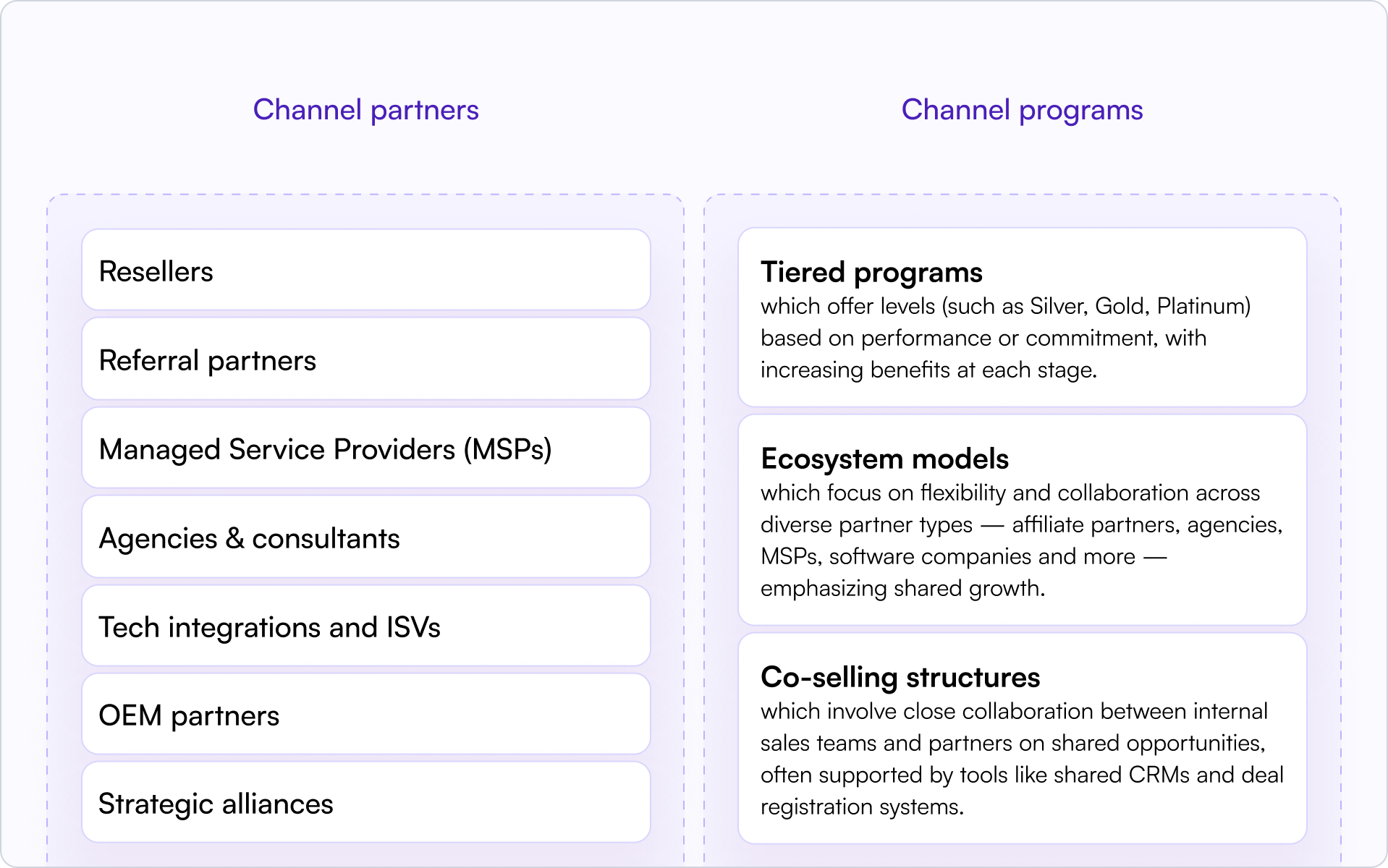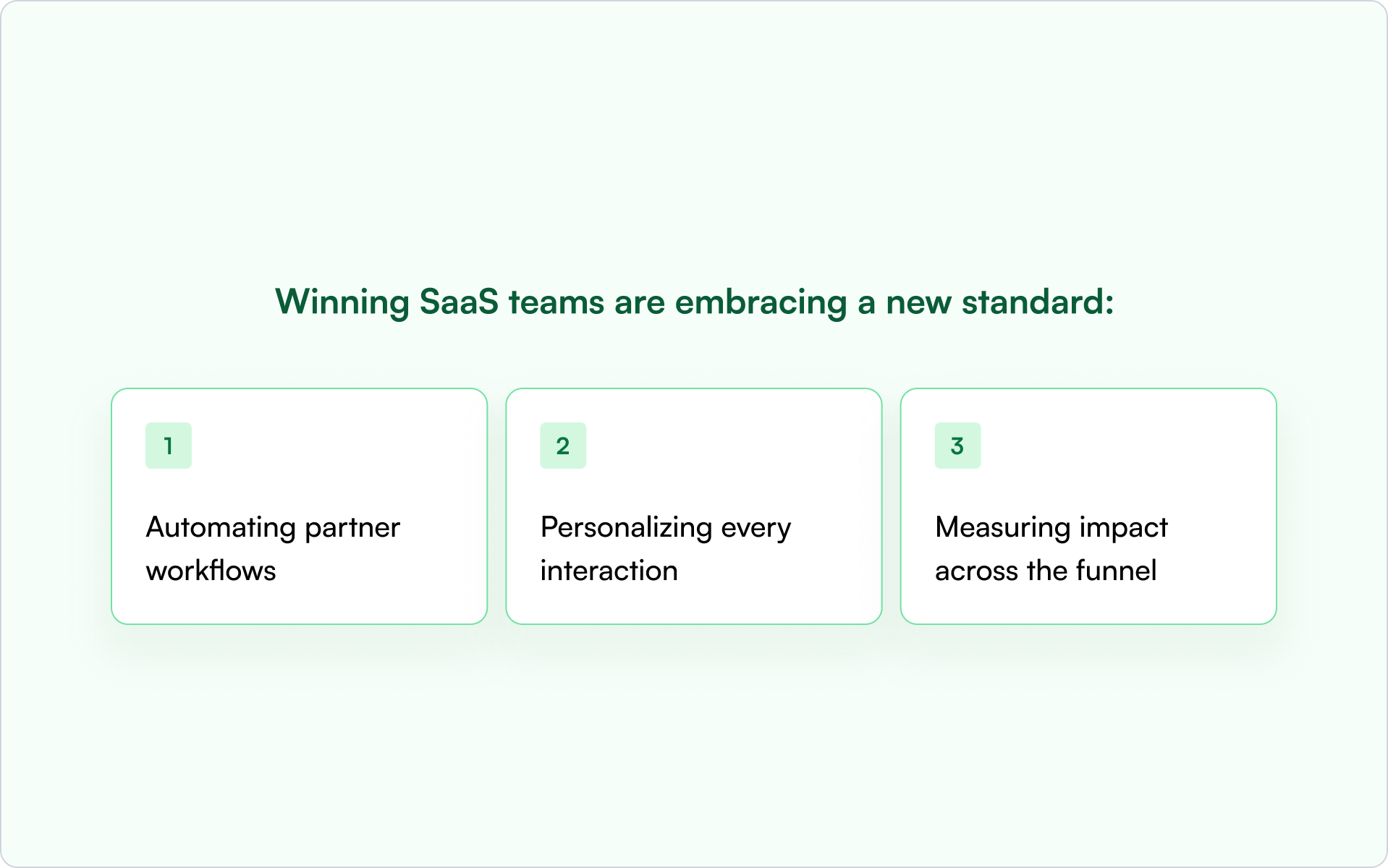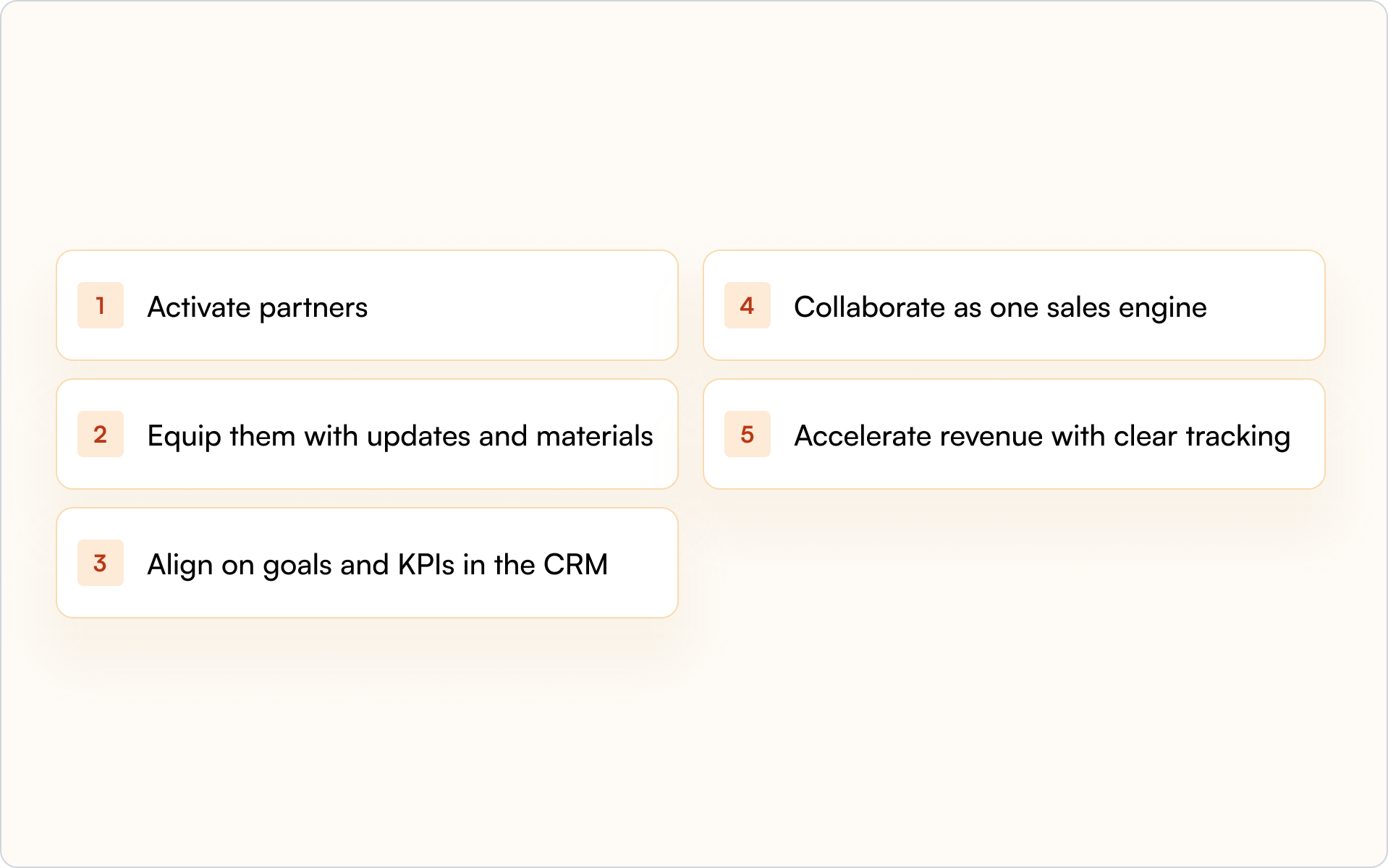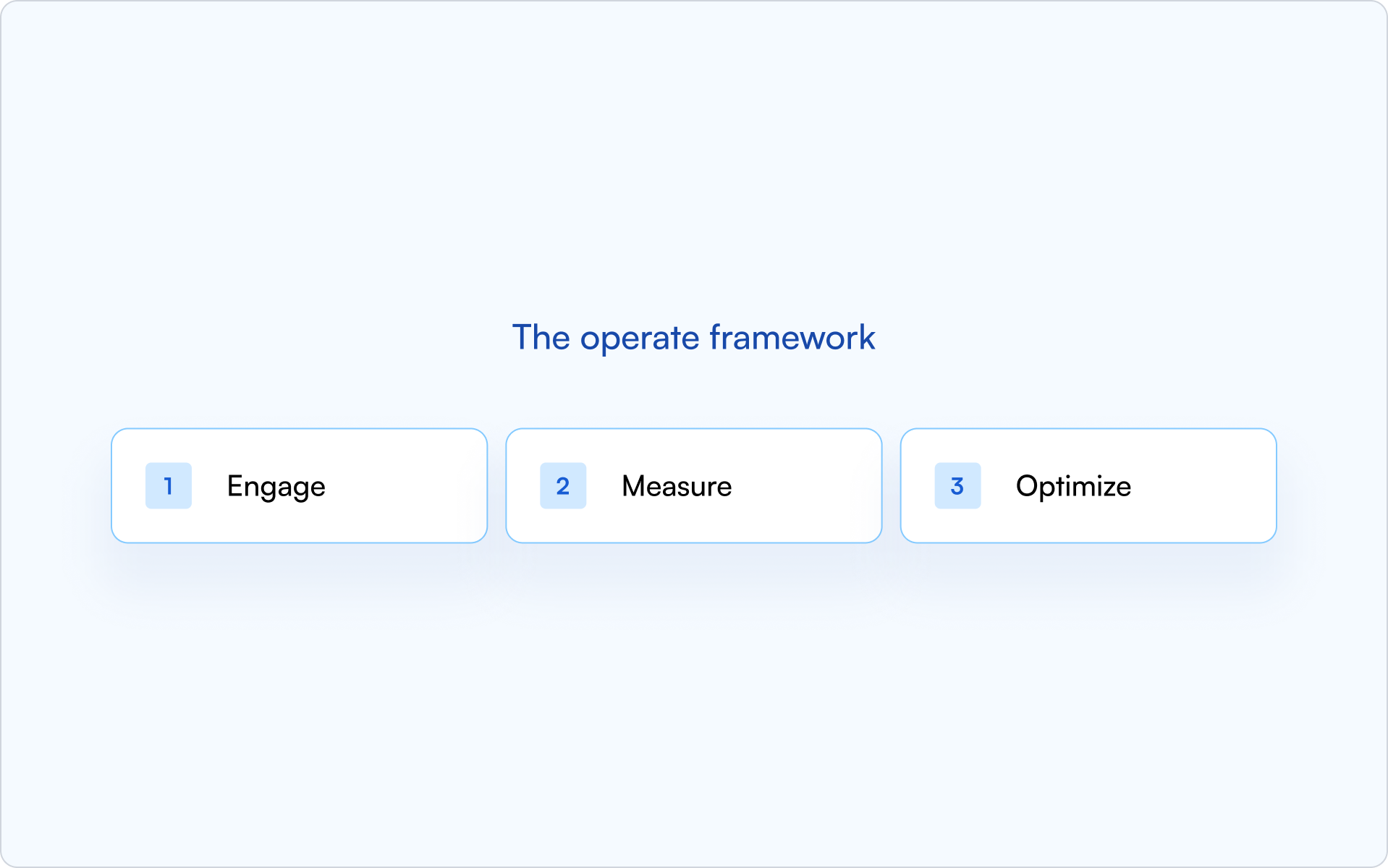SaaS brands are increasingly learning on channel partner programs to tap into new markets and accelerate growth without increasing sales team overhead. Within modern channel partner programs, companies collaborate with third parties, such as resellers or service providers, to market and sell their products. These ecosystems are a perfect fit for SaaS brands that are already using HubSpot or Salesforce. In this step-by-step guide, you'll learn whether a partner program is a good fit for you and how to build one from beginning to end.
Why Channel Partner Programs Matter in 2026
Channel programs have been around, in one form or another, for years.
After all, businesses have always recognized the benefits of having diverse revenue streams.
But it's only recently that these partnerships have been worked into formal strategies.
This is partially because we now have tech — such as partner relationship management systems (PRMs) — that allow us to easily manage and scale partner ecosystems.
But it's also because, in 2026, we need strategic partner programs more than ever.
Here's why.
The Shift to Ecosystem-Led Growth
Channel partners extend market reach, accelerate customer acquisition, and slash sales costs.
And in 2026, these benefits are extremely valuable.
After all, it's not easy out there — SaaS brands are now contending with intense market saturation, rising customer acquisition costs and longer sales cycles.
However, with the right go-to-market (GTM) strategy, there are huge opportunities in SaaS.
Indeed, partners help SaaS companies penetrate new regions and verticals more effectively, thanks to their established customer relationships and local market knowledge. Also, Partner Deals have a 32% bigger deal size and 2.8X higher win rate.
Companies with partner programs are also up to 5x more likely to exceed expectations on a variety of business metrics.
Partners provide value-added services like integration, customization, and support, enhancing customer satisfaction and retention.
As SaaS buyers increasingly seek solutions tailored to their specific needs, trusted channel partners act as advisors, boosting credibility and trust.
Additionally, leveraging partner networks enables SaaS providers to scale rapidly without significantly expanding internal sales teams, making GTM efforts more agile and cost-efficient.
Key Benefits for SaaS Companies
To recap, the four key benefits of ecosystem-led growth for SaaS companies are as follows:

- Scalable revenue: Partner ecosystems enable SaaS companies to grow revenue without a proportional increase in headcount or operational costs, creating a more efficient path to scale.
- Market reach: Partners provide access to new regions, industries, and customer segments that would be costly or time-consuming to penetrate directly.
- CAC reduction: By leveraging partners' existing customer relationships and brand trust, SaaS companies can significantly lower their CAC.
- Shorter sales cycles: Trusted partners can accelerate deals by guiding prospects through the sales process, reducing friction and time-to-close.
Are You Ready to Build One?
As outlined above, strong partnership programs have myriad benefits for SaaS brands.
However, not every company is in the right place to start building its program.
In order for your scheme to drive success, first you need to build the right foundations.
Is your company ready to start building your partnership scheme?
⬇️ If you answer 'yes' to the three questions below, you've got the green light!
- Do you have 2+ partner managers?
- Are you already using either Salesforce or HubSpot?
- Do you already have some partner traction?
Step-by-Step: How to Build a Channel Partner Program
So, we know why implementing robust partner programs is essential for many SaaS brands in 2026, and you've established that your business is primed to build one.
Here's how to build a channel partner program.

1. Define Your Partner Types
Start by clearly identifying the types of partners that best support your go-to-market goals.
These may include:
- Resellers who sell your product directly
- Referral partners who generate leads
- Technology alliances that integrate with your platform
- Managed service providers (MSPs) that offer bundled solutions
2. Design Your Incentive Structure
A well-structured incentive program is central to any modern partner program.
Due to the nature of partnerships, appealing incentives are the only impactful tool you have for motivating partner performance and aligning their efforts with your company's revenue goals.
Begin by deciding on core components such as:
- Commission rates
- Tiered benefits
- Performance-based rewards.
Set clear performance goals tied to strategic outcomes, and ensure alignment with your Chief Revenue Officer (CRO) and/or your Chief Customer Officer (CCO) to maintain focus on pipeline quality, ARR growth, and customer success.
Get your incentives right, and you should be able to drive partner behaviour and strengthen mutual accountability and long-term value creation.
3. Build Your Deal Registration Process
An efficient and friction-free deal registration process drives partner engagement and prevents channel conflict.
Start by creating a simple, user-friendly registration form that captures key deal information without overwhelming your partners.
Make sure the process is fast, intuitive, and clearly communicates the benefits of registering deals, such as deal protection or priority support.
To streamline operations, auto-map the registration system directly to HubSpot PRM or Salesforce PRM — automatically sending partner-submitted data to your sales pipeline.
In addition to slashing manual data entry, this integration also gives your revenue teams real-time visibility into partner-sourced opportunities, improving forecasting accuracy and cross-functional alignment.
📚 Read more: Top 10 Partnership Trackers: Driving Co-Sell Revenue in 2026
4. Enable Partner Engagement Tracking
To manage and optimize partner relationships effectively, you need clear visibility into engagement activity.
It's essential to gain visibility over:
- Emails
- Meetings
- Shared files
- Partner responses throughout the sales cycle
While once upon a time, this engagement tracking would have been a tedious time drain, in 2026, it can be super simple with the right tech stack.
Ensure your communication tools integrate with your PRM and customer relationship management (CRM) platform for centralized data, easy tracking, and a unified view of partner interactions.
For example, the Introw PRM boasts a super useful Slack integration.
Engagement tracking helps identify your most active and productive partners, enabling your team to strategically prioritize support and resources.
It ensures alignment across sales and marketing efforts and RevOps by making partner activity transparent, measurable, and actionable.
5. Set Up Real-Time Forecasting & Reporting
Ditch static spreadsheets and move to real-time, CRM-native forecasting to gain accurate, up-to-the-minute insights into partner performance and pipeline health.
By pulling data directly from your CRM, you ensure consistency, reduce manual errors, and save valuable time.
Real-time dashboards can display key partnership metrics such as:
- Deal stage progression
- Partner-contributed revenue
- Forecasted ARR
- Partner tier performance
This high level of visibility empowers both your partners and your RevOps teams to make data-driven decisions quickly, and helps to align cross-functional stakeholders, including your CRO and CCO, around shared revenue targets.
It also empowers channel managers to identify underperforming areas early and swiftly take action to adjust strategies or provide extra resources.
In short, real-time forecasting transforms your partner program into a measurable, predictable growth engine.
6. Create a Repeatable Co-Selling Motion
A structured, repeatable co-selling process is key to turning partnerships into pipeline.
Indeed, running disjointed or unstandardized partnership processes is a quick way to lose partners and prospects and waste time and money.
So, how can you create a repeatable co-selling motion?
Begin by establishing regular joint pipeline reviews with your partners to align on deal status, next steps, and mutual priorities.
Use these sessions to identify blockers, share insights, and reinforce accountability on both sides.
Implement mutual action plans for key deals — clearly outlining responsibilities, timelines, and partner success criteria for each party.
This keeps everyone focused and reduces deal slippage.
To scale co-selling effectively, invest in a PRM platform like Introw that integrates with your CRM.
A strong PRM centralizes your partner information and enables the tracking of joint opportunities, document sharing and communication, ensuring nothing falls through the cracks.
Using your PRM, it's easy to set up standardized processes for partners within your PRM, ensuring the same workflows are followed, and the same milestones are hit from the start to the end of the sales cycle.
By standardizing your co-selling motion, you not only drive consistent results but also create a more predictable, scalable path to revenue — turning ad hoc collaboration into a high-performance engine for growth.
7. Launch Your Partner Portal or Experience
It's time to launch your partner portal!
Modern partner engagement requires a frictionless, branded experience — this is where your partner portal comes in.
For instance, Introw offers a modern, user-friendly partner portal that simplifies and enhances collaboration between businesses and their partners.
The portal is fully white-labeled, allowing companies to customize it with their branding.
Another standout feature is the no-login-required access, enabling partners to interact with the portal through secure links via email or Slack.
This approach reduces friction, making it easier for partners to register deals, access resources, and stay engaged without the hassle of managing additional login credentials.
What's more, the portal integrates seamlessly with popular CRMs like Salesforce and HubSpot, ensuring that all partner activities are automatically synced, providing real-time visibility into the sales pipeline and partner performance.
Further reading: Here's everything you need to know about choosing Your Next PRM
8. Run Ongoing Reviews and Optimize
Building a successful partner program isn't a one-time effort — it requires continuous evaluation and improvement.
To build agility and responsiveness into your program, establish monthly review sessions with key partners to assess performance, pipeline health, and alignment with mutual goals.
Use Mutual Action Plans and clearly defined KPIs to guide these reviews, focusing on metrics like deal velocity, close rates, and partner-sourced revenue.
These sessions should provide your business and your partners with a forum to identify what's working, uncover bottlenecks, and refine strategies collaboratively.
It's crucial to ensure alignment with your Chief Revenue Officer and RevOps team, too, so that partner activity is directly tied to overall revenue outcomes and forecasting.
Think of it this way — regular reviews turn your channel into a living, evolving asset that consistently delivers results.
Channel Partner Program Best Practices (2026)
So, when building a strong, modern channel partner program, which best practices produce the best channel partner programs?

1. Operational Excellence for RevOps
RevOps plays a critical role in driving the efficiency and scalability of your channel partner program.
To deliver operational excellence, start by ensuring that you have clean, consistent CRM data — accurate partner attribution, deal stages, and source tracking are essential for reporting and forecasting.
Then, implement structured partner segmentation.
This segmentation allows you to personalize your engagement, enablement, and incentives based on partner type, performance, and potential for better results — saving you time while driving engagement.
Furthermore, to achieve true operational excellence in 2026, you will need an outstanding and thoughtfully-assembled tech stack.
You can leverage no-code tools to automate workflows, integrate systems, and scale processes — empowering you to scale without heavy reliance on technical support.
2. Keeping Partners Engaged
Sustained engagement is key to a successful channel partner program.
Indeed, timely, relevant communication keeps your solution top-of-mind and builds trust over time.
It's crucial to use communication and engagement tools that integrate with your partner portal — such as email or Slack — to streamline communication.
A strong level of communication surrounding deal progress, next steps and mutual responsibilities provides much-needed visibility into the shared pipeline, ensuring partners stay informed.
Think instant notifications for new leads, updates, or closed deals.
Consistent, transparent updates turn partners into proactive, invested collaborators, driving more pipeline and stronger results.
3. Building for Scale, Not Chaos
As your partner program grows, consistency becomes critical, and the risk of chaos rises!
Constructing a scalable foundation not only accelerates growth but also allows your team to focus on strategy rather than chasing down processes or managing one-off exceptions.
So, how can you ensure you're building for scale rather than running headfirst into operational chaos?
Start by creating standardized templates for key processes — like onboarding, deal registration, co-selling, and reporting.
These templates will save you time, reduce errors, and make it easy to bring on new partners without reinventing the wheel.
At the same time, you can use your PRM, CRM, and communication tools to customize workflows and content based on partner type, maintaining flexibility and ensuring relevance while preserving operational flexibility.
📚 Read more: 10 Best Practices for Channel Management
Common Pitfalls to Avoid
As with any large project, most SaaS companies will face several challenges while implementing their channel partner program.
Here are the pitfalls to look out for and avoid. /

1. Manual Systems Outside the CRM
Relying on spreadsheets, email threads, or disconnected tools to manage partner activity creates inefficiencies, errors, and data silos.
These manual systems make it difficult to track deal status, attribute revenue accurately, or forecast effectively.
Worse, they hinder collaboration between sales and partnerships teams.
Centralizing all partner data and workflows inside your CRM through integrations and a CRM-first PRM like Introw ensures real-time visibility, better alignment, and a scalable foundation for long-term business growth.
2. One-Size-Fits-All Portals
Generic partner portals often fall short by failing to meet the unique needs of different partner types, and a lack of branding can also cause a drop in trust.
Furthermore, without tailored experiences, engagement drops and partners struggle to find relevant resources.
Customizing content, workflows, and portal access based on partner roles ensures higher activation, better collaboration, and a more productive, scalable ecosystem.
Meanwhile, the option for branded portals should help to build partners' trust in your business.
3. Misaligned Incentives or Comms
Engagement and performance suffer when incentives or communication strategies don't align with partner goals.
For example, overly complex rewards or unclear messaging can lead to confusion and missed opportunities.
Instead, ensure that incentives are simple, outcome-driven, and well-communicated.
Regularly sync with partners to reinforce alignment and keep both sides focused on shared revenue and success.
How Introw Simplifies Every Step
Building a channel partner program may sound complex, but — with the right PRM — it can be pretty straightforward.
Here's what Introw brings to the table.
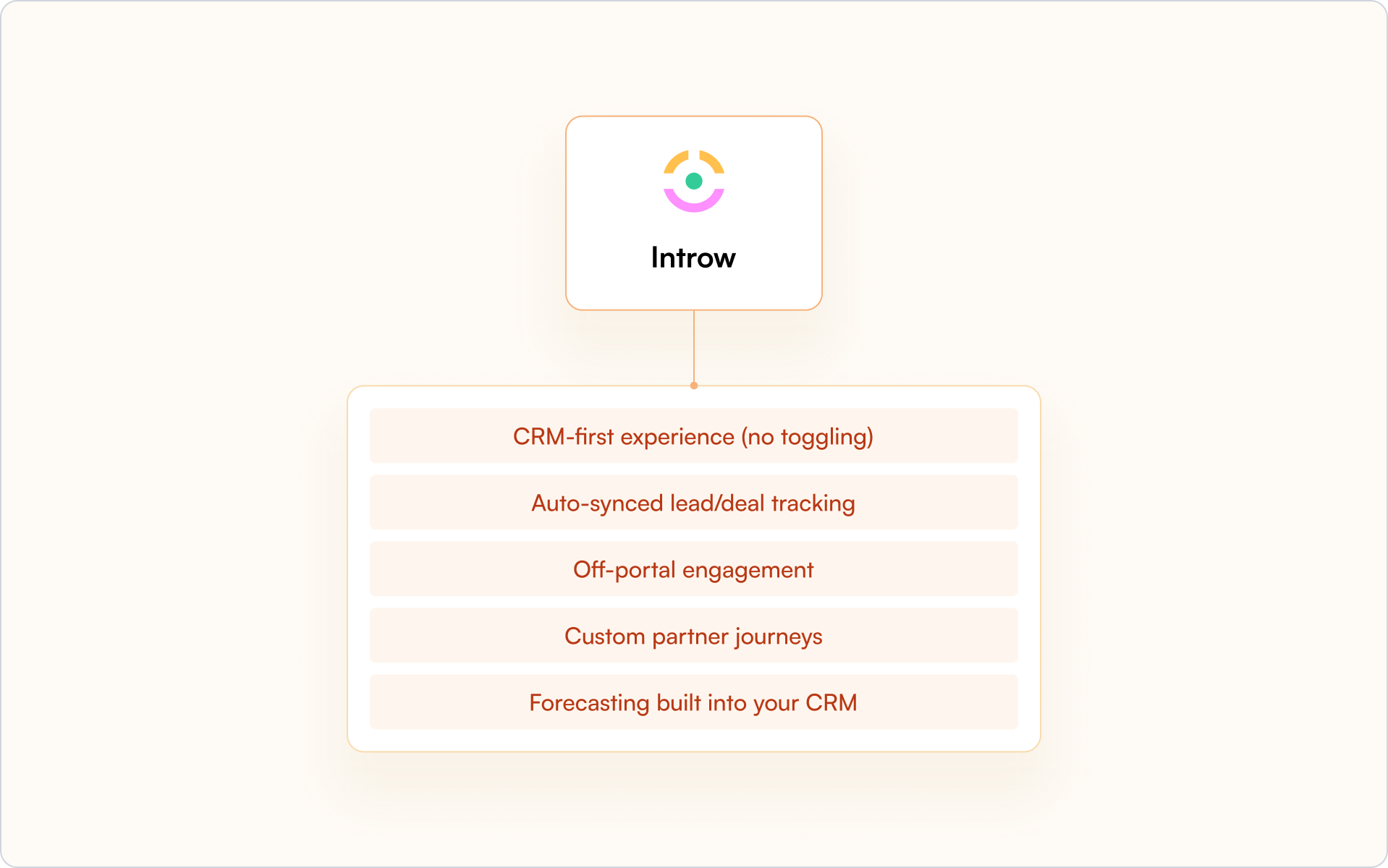
- CRM-first experience (no toggling): Introw keeps your CRM as the single source of truth, eliminating the need to switch between multiple platforms. Integrating directly with systems like Salesforce and HubSpot ensures that all partner activities are centralized, streamlining workflows and reducing manual data entry.
- Auto-synced lead/deal tracking: Leads and deals submitted by partners are automatically detected and tracked within your CRM. This ensures real-time visibility into partnership revenue and eliminates the need for manual updates.
- Off-portal engagement: Partners can submit leads, collaborate, and stay updated via Slack, email, or shared deal workspaces, all of which are seamlessly synced to your CRM. Or, they can enter the Introw partner portal to find all the resources they need.
- Custom partner journeys: Automate and customize partner journeys based on partner type or tier. This enhances engagement by delivering relevant content and interactions.
- Forecasting built into your CRM: By integrating partner data directly into your CRM, Introw enables real-time forecasting and reporting. This integration provides accurate insights into partner performance and pipeline health, facilitating data-driven decisions and aligning partner activities with overall revenue goals.
📚 Further Reading: Find The Best PRM Software For Your Agency
Ready to Scale Your Channel in 2026?
Is your SaaS business ready to build your own channel partner program?
To recap, here's how to start benefiting from your partnerships in eight straightforward steps:
- Define your partner types
- Design your incentive structure
- Build your deal registration process
- Enable partner engagement tracking
- Set up real-time forecasting and reporting
- Create a repeatable co-selling motion
- Launch your partner portal or experience
- Run ongoing reviews and optimize
In 2026, cutting-edge tech tools make the process of operating partner programs much smoother and way more scalable.
Introw helps SaaS companies launch, manage, and scale high-performing partner ecosystems — without the complexity.
From CRM-native deal tracking to no-login partner experiences, Introw gives you everything you need to activate partners and drive revenue from day one.
This PRM is perfect for SaaS brands that use HubSpot, Salesforce or Slack.
🚀 Book a live demo today and start building a partner program your CRO will love
📚 Next Read: The Ultimate Partnership Marketing Guide for 2026: Strategies, Examples & Tips
What Is A Channel Partner Program?
A channel partner program is a business strategy where a company collaborates with third-party partners — for example, resellers, affiliates, or service providers — to market, sell, or support its products or services. These partners are given resources and training and put on a commission scheme, and in return, they help expand the company's reach and drive revenue growth.
How To Build A Channel Partner Program in 2026?
When building a professional channel partner program, start by defining clear goals, identifying your company's ideal third party collaborators — such as service partners or a reseller channel partner program — and creating a structured onboarding process. You must also invest in the necessary tools — such as a sophisticated PRM platform — to ensure your channel partner program is competitive. The next step is to develop training, marketing support, and those all-important incentive plans to boost channel sales. Now, establish communication channels (such as Slack or email), track performance with KPIs, and continuously optimize the program based on partner feedback and business outcomes.
What Are Channel Partner Program Best Practices in 2026?
When setting up an effective channel partner program, it's crucial to set clear goals, choose the right partners, deliver high-quality training programs, offer competitive incentives, maintain open communication, regularly evaluate performance, share marketing resources, foster strong relationships, track key metrics, and continuously adapt the program based on data analysis, market trends, and partner feedback.
What Is An Example Of A Partner Program?
Let's take a hypothetical cloud software company as an example. Say the brand launches a channel partner program to expand its market reach. The program has three tiers — Bronze, Silver, and Gold — based on channel partner performance and technical expertise. Every channel partnership will receive benefits like product training, co-branded marketing materials, dedicated account managers, and revenue-based incentives. But Silver and Gold partners gain access to lead-sharing and early product releases. The cloud software company also hosts quarterly webinars and annual partner summits to maintain engagement. By supporting resellers and managed service providers, this program helps partners grow while driving greater adoption of its cloud solutions across new regions and industries.


.svg)
























